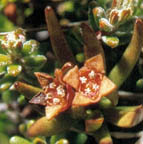
 |
Nanodeaceae Nickrent & Der |
The Enigmatic
Taxon Mida fernandeziana
This plant was known
only from the Juan Fernandez Islands off the coast of Chile. It was
originally named Santalum fernandezianum F. Phil. in
1892. Sprague and Summerhayes (1927), based on the presence of a
short, cupular perianth tube and a sessile stigma, suggested a
relationship to Mida salicifolia from New Zealand.
Accordingly, they transferred the taxon to this genus, thus creating
the name Mida fernandeziana (Phil.) Sprague &
Summerhayes. Unfortunately, the last known tree of this species from
the island of Masatierra died between 1908 and 1916. Skottsberg (1930)
looked into the taxonomic issues surrounding this plant and others
related to the sandalwood genus Santalum. At that
time, Skottsberg supported the concept of the genus Eucarya
that we know today is a component of Santalum. Regarding Mida
salicifolia, he said
"Mida
differs from Santalum and Eucarya as well as from
most Santalaceous genera by its remarkable tepals. DeCandolle (4, p.
686) remarked on their structure: "lobis a tubo basi bene distinctes
et facile segregatis" ['with lobes distinct to the tube base and well
separated']. Apparently Sprague and Summerhayes did not pay any
attention to this character or they would not have brought Santalum
fernandezianum to Mida. They do not even mention the
tepals."
The "tepals" (now
considered petals) of S. fernandezianum are indeed
remarkable. As illustrated well by Cheeseman
(1914) and the University
of Aukland website photos, they are cordate, narrowing almost to
a "claw" (as seen in Malpighiaceae) when they insert on the perianth
tube (or hypanthium). Between the petal lobes at the rim of the
hypanthium are bulges. These bulges were equated with a calyculus by
Bhatnagar (1960), a term also used in Nickrent et
al. (2010). Kuijt (2015) disputed the existence of a calyculus
in Mida, claiming that the illustration by Cheeseman (1914)
showed "nothing of the sort". Looking at Cheeseman's illustration, one
can see that he accurately drew the bulges present between the petals.
Moreover, he shows a rim of tissue at the top of the (immature)
fruit. Looking at the photo of mature, bright red fruits from
the Univ. of Aukland website, one can see that after the petals
dehisce, a dark rim of tissue remains that encircles the fruit apex.
In my estimation, this represents a calyx vestige, i.e. a calyculus.
In addition to
recognizing that the Juan
Fernandez Island taxon was a Santalum, Skottsberg
went on to compare it with species of Santalum that have
short perianth tubes and sessile stigmas, such as S. insularis
(= S. insulare, Sect. Polynesica) and S.
(Eucarya) acuminata. You can see his illustrations
of flower longitudinal sections HERE.
So is the Juan
Fernandez Island taxon really a Santalum or Mida?
Enter molecular phylogenetics! Harbaugh and Baldwin
(2007) sequenced the chloroplast gene 3' trnK intron and
found that S. fernandezianum came out with S. acuminata,
very close to what Skottsberg (1930) had suggested. Biogeographically,
this also suggests a dispersal from Australia to Juan Fernandez
Islands. These authors state "... evidently, Sprague and Summerhayes
(1927) were not so far off after all", but I would argue that
Skottsberg was closer to the mark. Recall that Sprague
and Summerhayes placed the Juan Fernandez taxon in Mida.
Skottsberg (1930) said "I cannot even suggest where Mida
comes in", which is certainly understandable now because Mida
is not closely related to Santalum. Molecular
phylogenetic data (see Der
& Nickrent 2008; Nickrent
et al. 2010) show that Mida (from New Zealand) and Nanodea
(from Patagonia of South America) are in a family distinct from
Santalaceae sensu stricto, i.e. Nanodeaceae. These taxa likely
represent a Gondwanan lineage that share an ancient ancestor dating to
the time the southern continents were more proximal.
Nanodea
